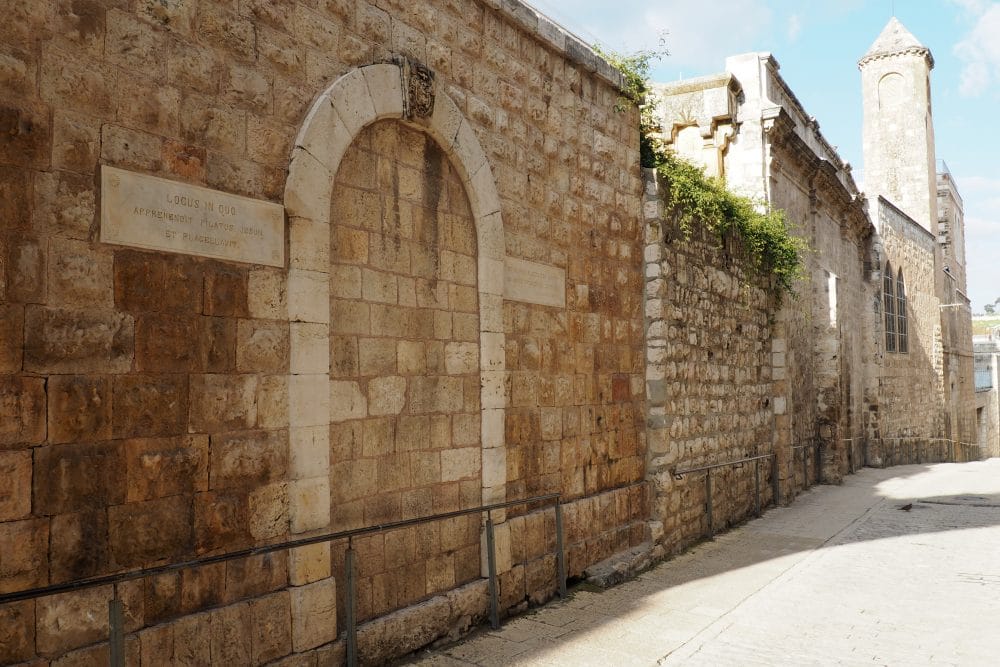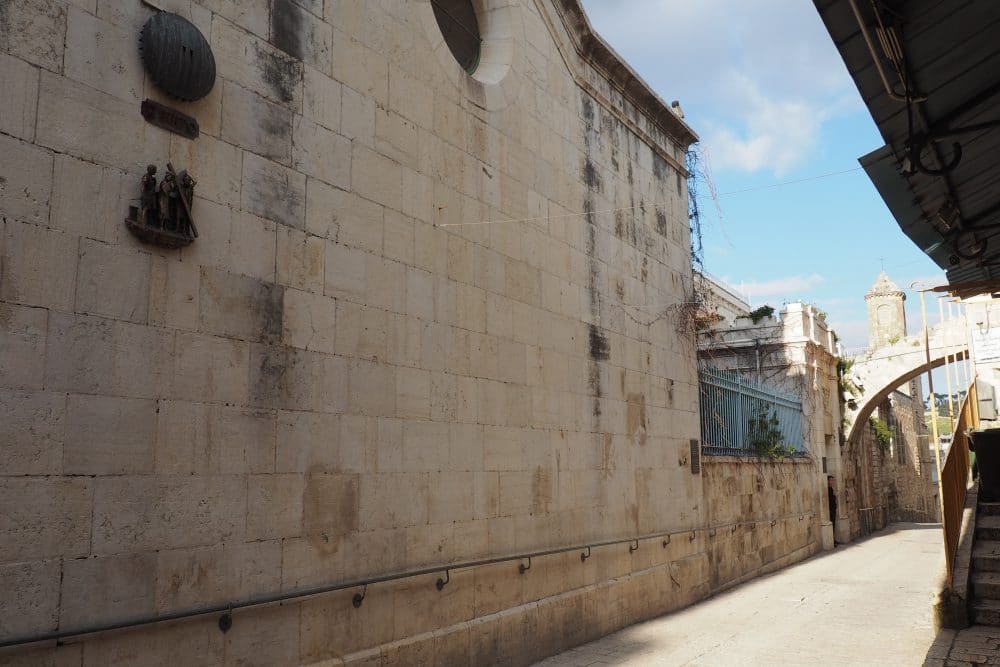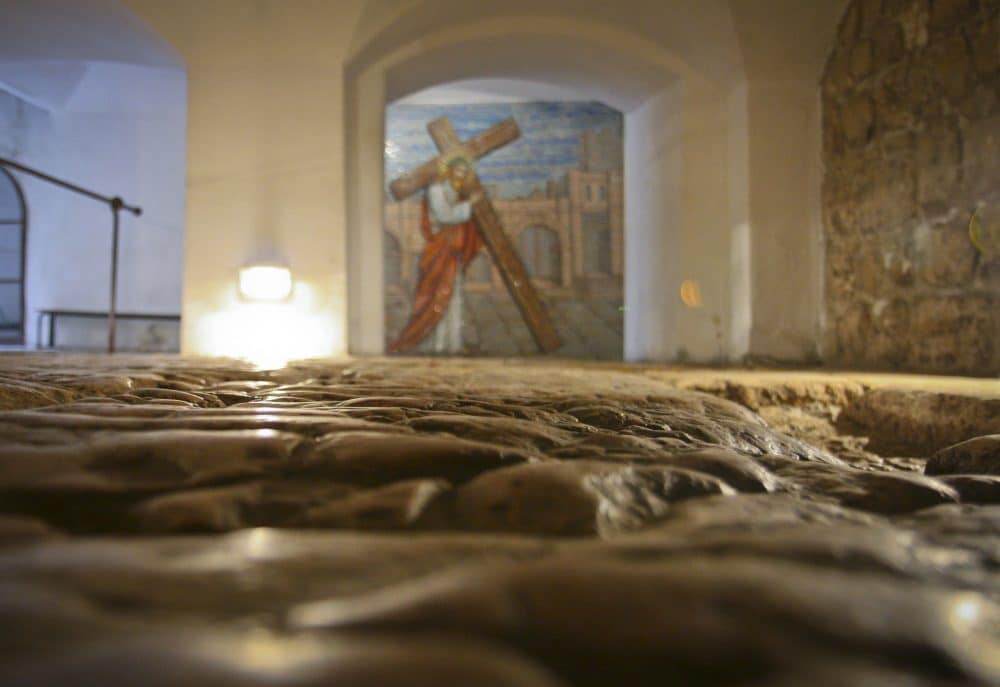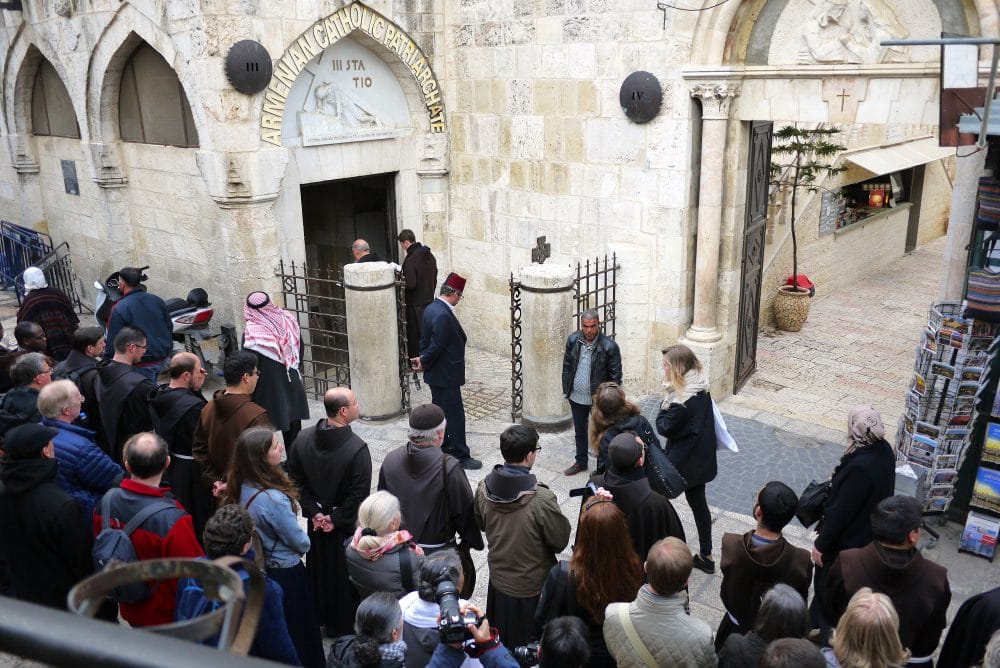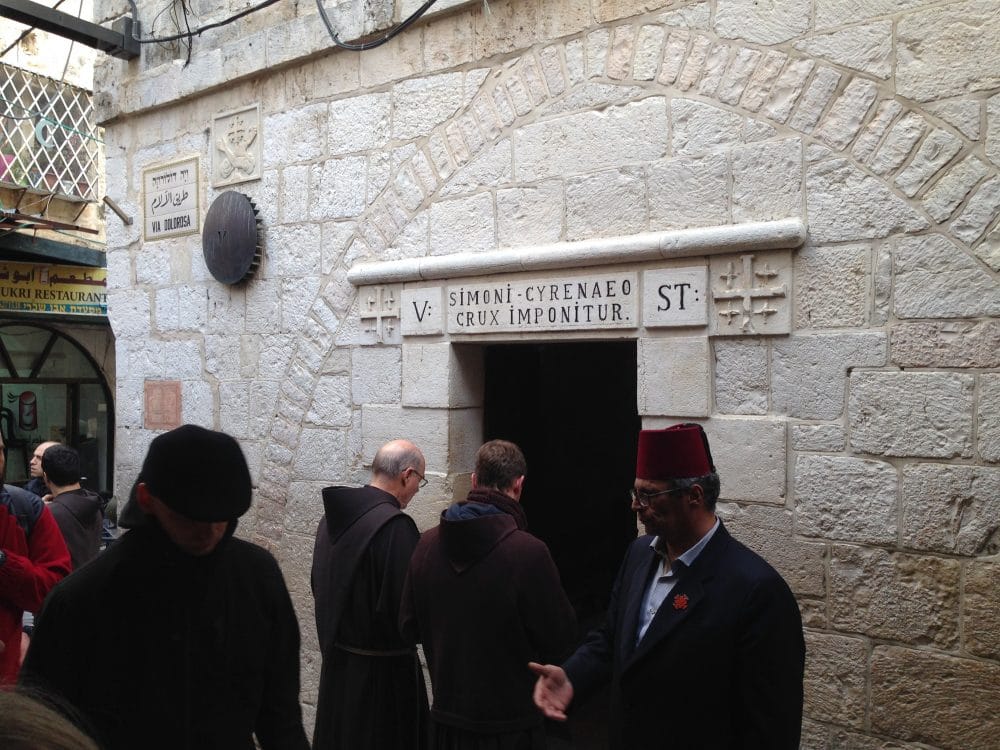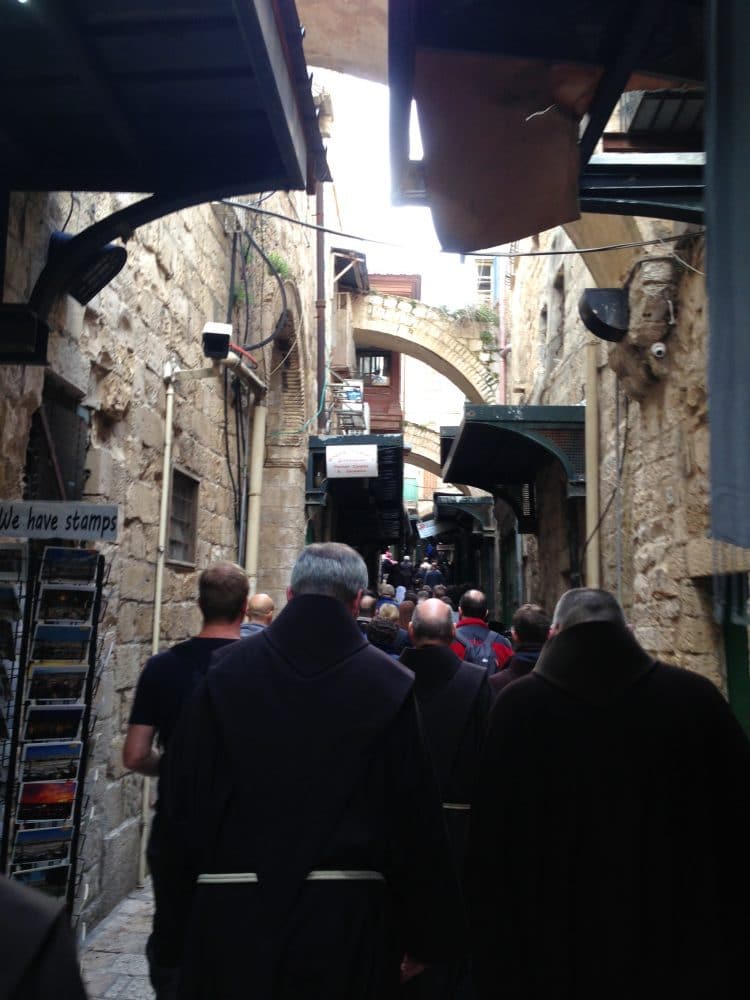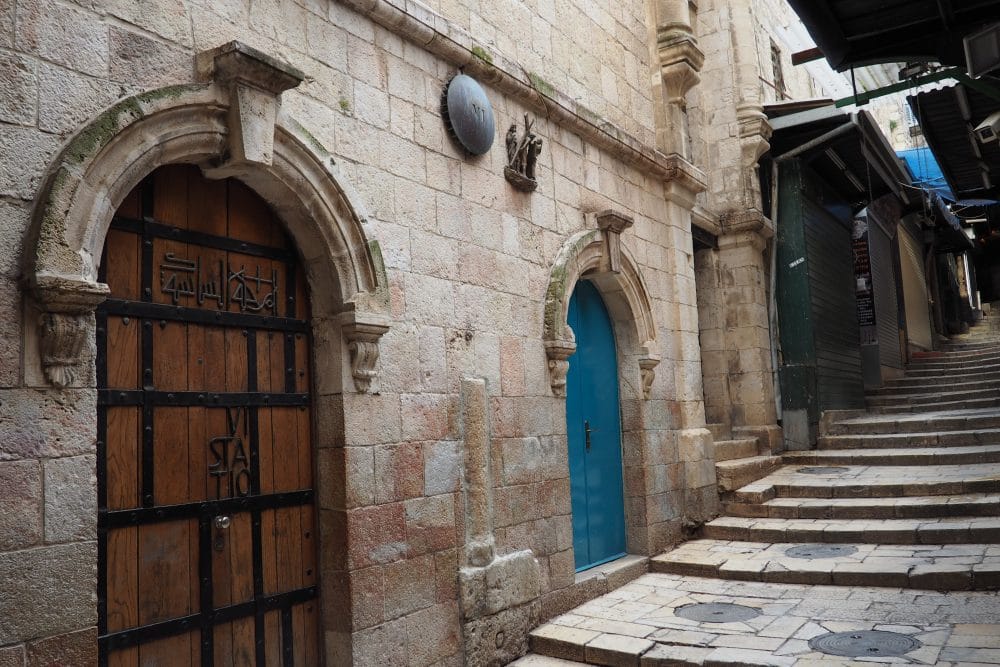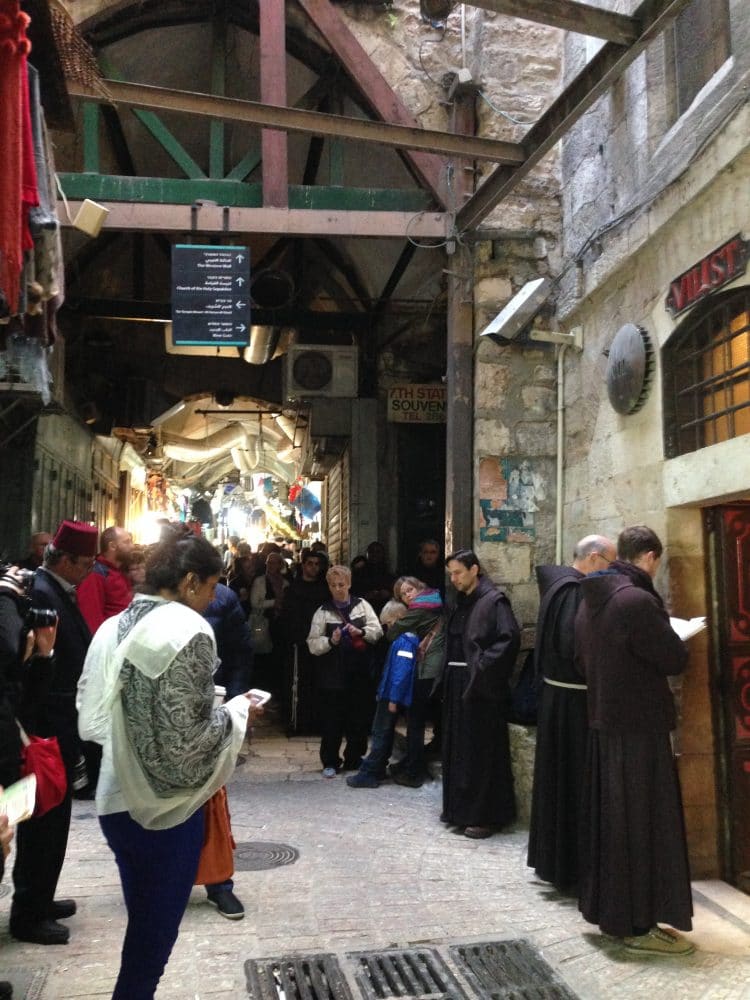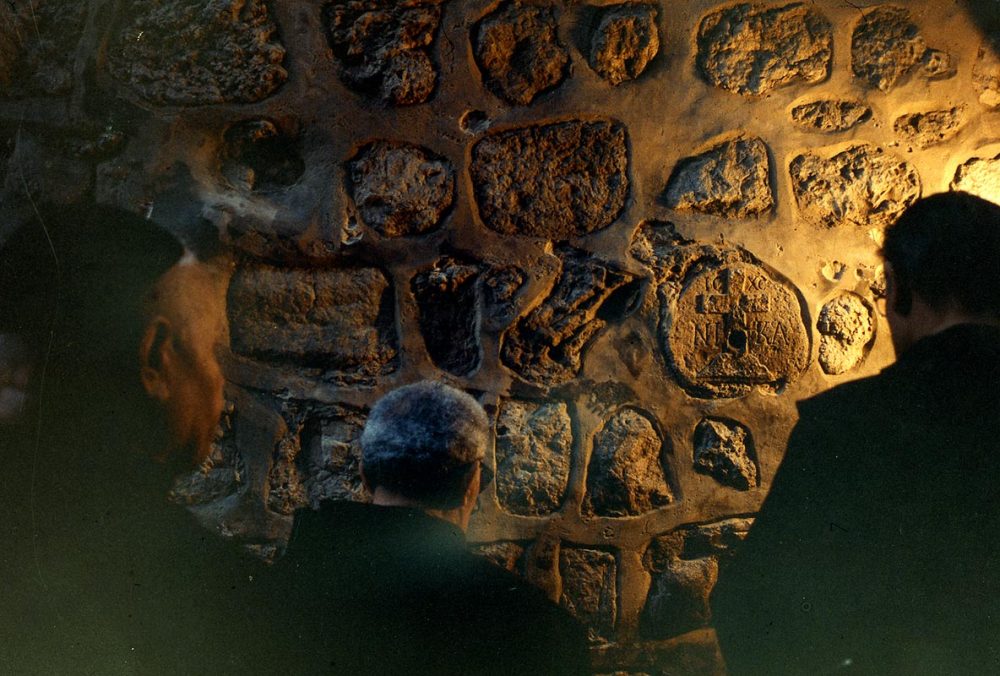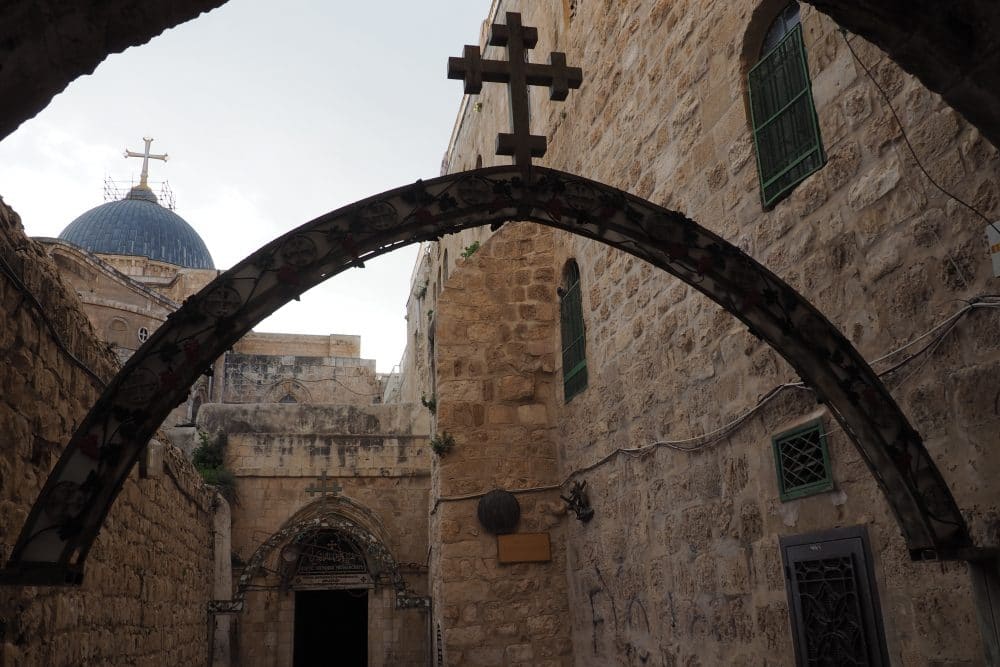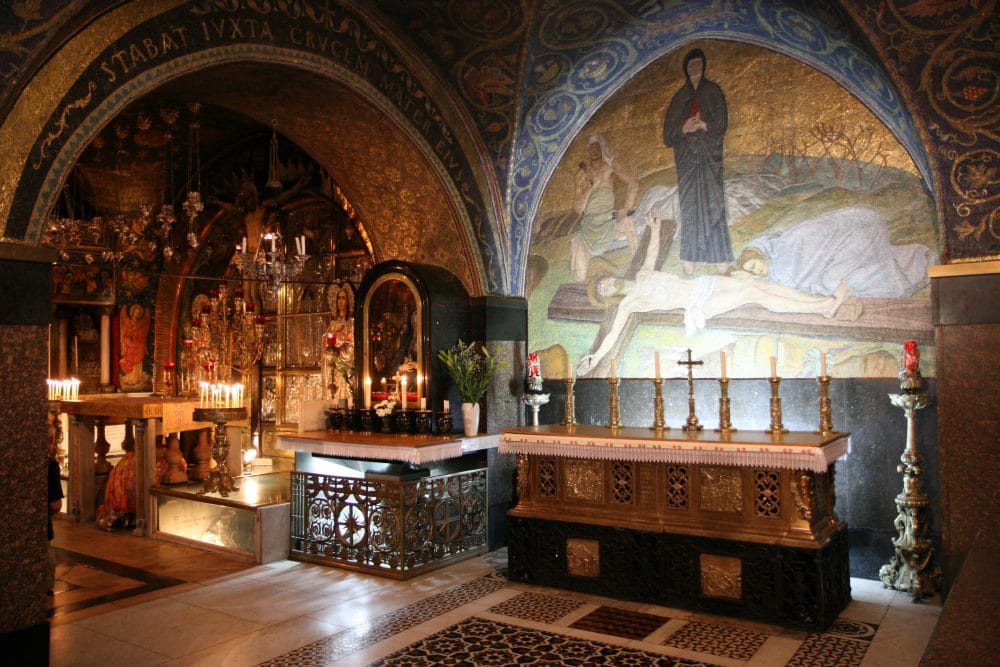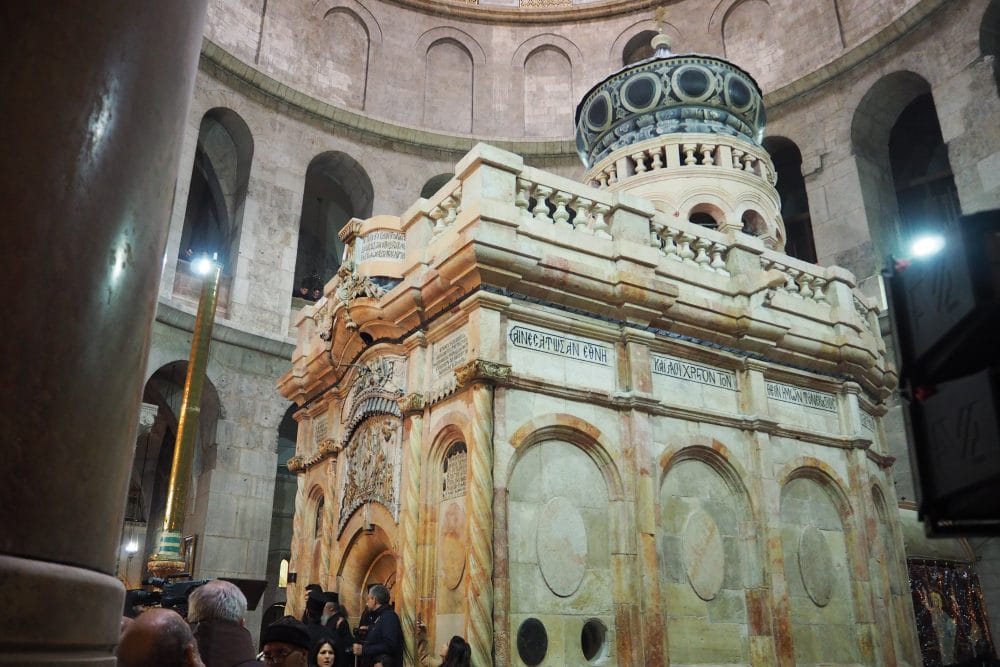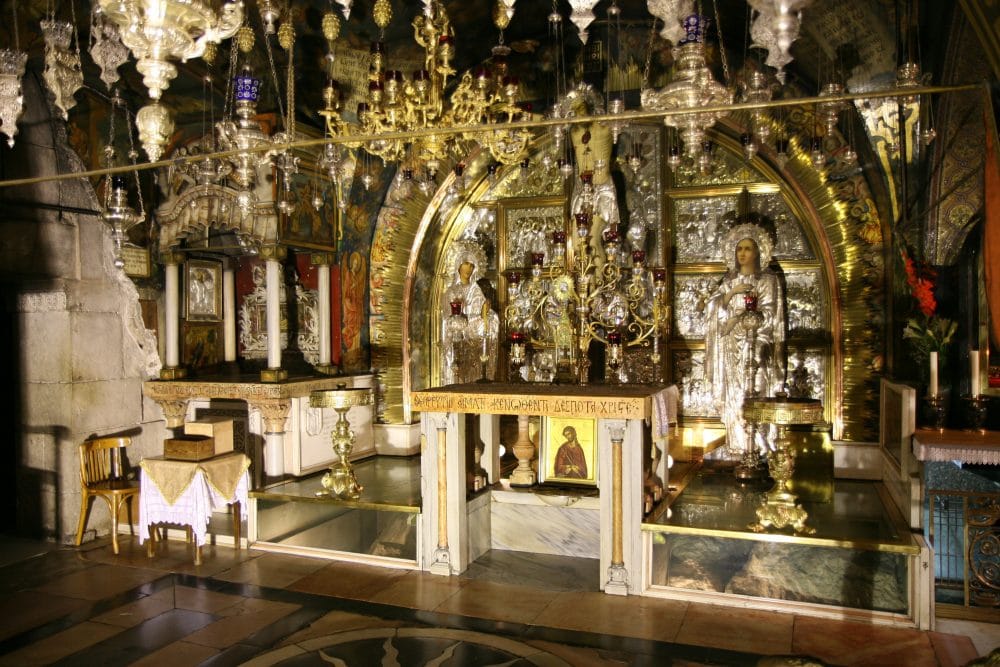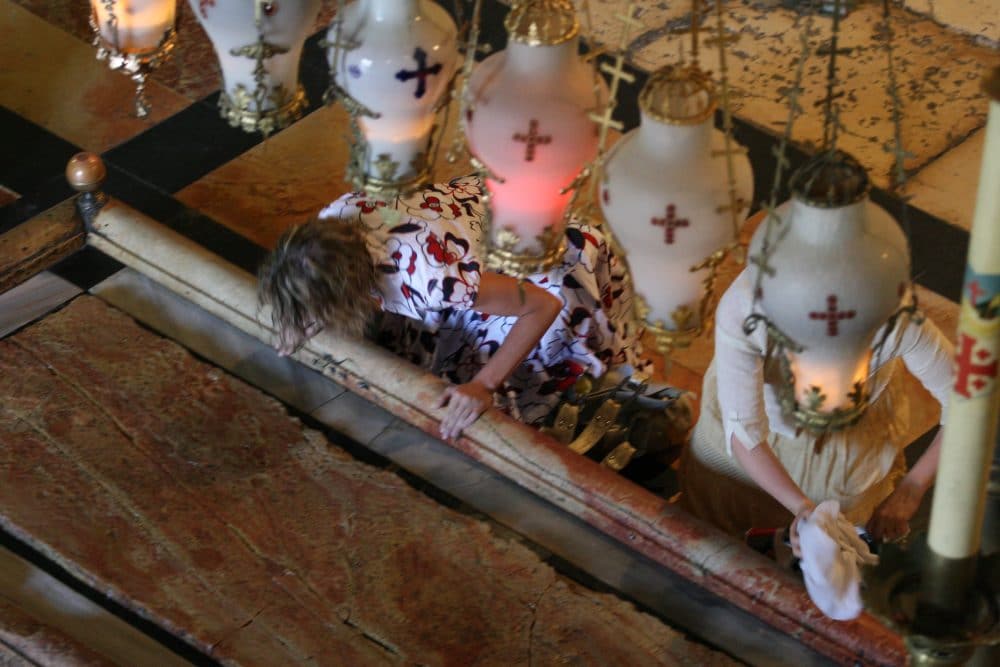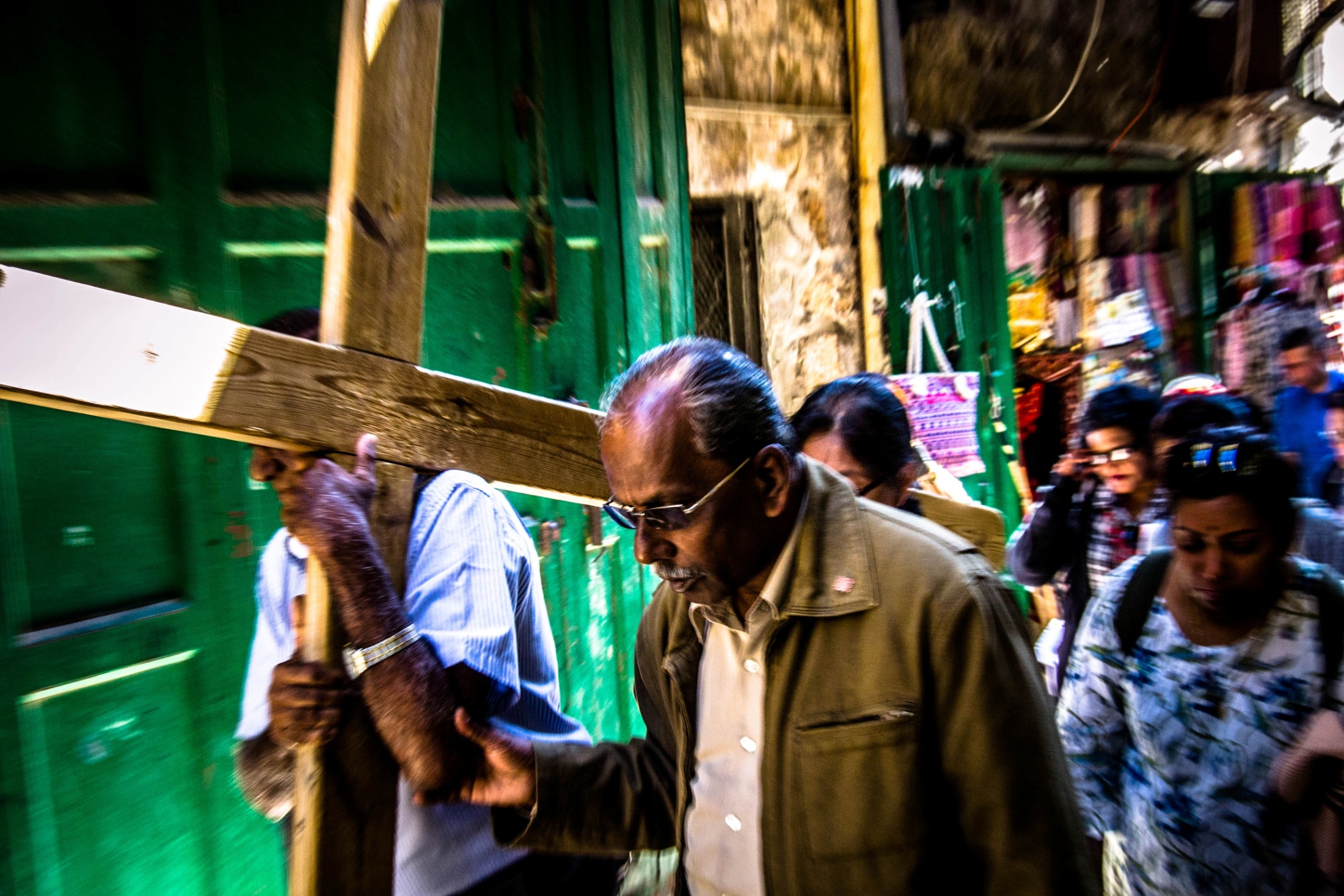
The way of the Cross: history, devotion, faith… and quirks!
The Way of the Cross begins with kids screaming and playing in the courtyard of the al-Omariyya Islamic school. Hidden in the underground, below the feet of pupils and pilgrims, the remains of a huge roman fort. The once majestic rectangular building with four towers known as Antonia Fortress stood in the north-west corner of the Mount Temple, controlling the movements of Jewish people in Jerusalem’s temple. The fortress was destroyed with the temple by romans themselves under the command of Titus in 70 A.C.. In the 16th century what was left of the building was used to build the palace of the Turkish governor. As a result it was natural for pilgrims, coming from the old continent in order to visit the terrestrial Jerusalem and doing so to obtain access to paradise, to identify the Antonia fortress or the palace of the governor, as the location of the roman praetorship. Here Pontius Pilate stayed when, left his mansion in Caesarea, he came in Jerusalem to give orders to the troops and administrate the justice. Here Jesus was condemned to death. Here also stands the first station of the Cross.
The second stations is located inside the chapel of the Condemn and imposition of the Cross in the church of the Flagellation. The church was built by Franciscans in the first half of the 19th Century on the medieval remains returned to the religious order by the governor of Egypt Ibrahim Pasha. The funds used for the operation came from the very first Bavarian pro terra Sancta collection and were brought in Jerusalem by Maximilian of Bavaria the first. Restored in a medieval-like manner by the architect Barluzzi Antonio in 1927-29, the same author of the basilica of the Transfiguration of Mount Tabor and of the church the Agony in the mount of Olives, the location of the second station is characterized by the flooring made by reused stone slates where the roman chariots’ cut is still visible. From here we are tacking the Via Dolorosa sassing under the Ecce Homo arch, a roman triumphal arch with three fornixes dating back at 135 A.C. and now incorporated in the homonymous basilica after being enriched with a two windows loggia. According to the tradition born with the first pilgrims, from this loggia Pilate introduced Jesus to Jerusalem’s people with the words “Ecce homo” or “Here is the man”, explaining the name of the basilica.
In the late Middle Age, the Via Crucis ended at the 7th station but we will now cross the market and climb up a little bit more. On the wall we will walk by there is a very peculiar graffiti: a small Malta cross and the Greek letters IC XC NIKA meaning “Jesus Christ Victorious”. Here is the eight station where Jesus comforted the ladies of Jerusalem (luke 23, 28). The path is now at a dead-end and, in order to reach the ninth station, we will go back to the market and toward the Coptic Patriarchate. Here a column reminds us where Jesus fell for the third time. Going through a small passage in between the cells of the Ethiopic orthodox monks where once the courtyard of Saint Elena chapel stood, we will take a shortcut and end to the Holy Sepulcher were the last five stations are.
Following the route going towards Damascus’ Gate, you’ll get to the third station where Jesus fell for the first time. The place is signaled by a 19th Century chapel belonging to the Armenian Catholics. The fourth station, the one where Jesus meets his mother Mary, is at the entrance of the Armenian Patriarchate. The church of “the fainting of Our Lady” is a 19th Century building standing on the remains of a roman villa and a byzantine temple dedicated to the goddess of knowledge, Sophia, as the mosaics discovered under the flooring may suggest. Something rather curious: the sandals of the mosaic were presented to pilgrims as the footprints of Jesus or Mary. Reality is that the subject was rather common at the time and was usually reserved to entrance halls to suggest people visiting to take their shoes off in order not to dirty up the floor! The meeting between Jesus and Simon of Cyrene, the one helping Jesus transporting his cross, happened nearby a small Franciscan oratory dated to the end of the 19th Century standing next to a building identified in the 15th Century as the house of the rich Epulon (Luke 16, 14-31).
We are now in front of the most characteristic tract of the way of the Cross: a long stairway with arches above going up to the current bazar, the marketplace. The sixth station, where Veronica cleans Jesus’ face, is here. Veronica has a specific etymology: in Latin “vera” means “real” and in Greek “eikon” means “image”. The features of Jesus’ face were miraculously impressed on a cloth, in a similar way to the Holy Shroud venerated in Turin. The episode is also reminded in the popular orthodox icons of the Mandylion and of the Acheropita Christ, the “not made by human hands” one. Going up you’ll end up at cross between the Cardo maximum (the North-south axis) and the decumano (East-west axis) of the roman time Jerusalem, known as Aelia Capitolina. This is a colorful and loud neighborhood: it’s the location of the Old city market, the bazar. Between stands and merchants, the Franciscan church hosts the seventh station where Jesus fell for the second time.
Along the southern aisle of the Basilica we are reminded of the episode of Jesus undressed of his robes and going on towards the chapel of the Calvary we will end up at the eleventh station where Jesus is nailed on the cross, a very humiliating torture reserved by romans to slaves. At the East end of the left aisle there is a silver disc hidden under the orthodox altar as a signal of the place where the cross stood up, the station number twelve. At the right of the altar there is a split in a rock said to be the one opened by an heart quake at the very moment Jesus died (Matthew 27, 51). The rock reminds us of the presence of the chapel of Abraham underneath, the grotto were Goffredo of Buglione, commander of the crusaders during the occupation of Jerusalem in 1099 A.C., and his brother Baldovino, first Latin king of Jerusalem, were buried. Nearby the Latin altar there is the station number 13 dedicated to the deposition, an episode traditionally linked to the Anointing.
The Stone of the Anointing Stone, nearby the main entrance of the basilica, is a red marble stone slab above which eight lanterns are suspended as a reminder of the faiths worshipping the relic. In order to reach the last station of the way of the Cross, the tomb of Christ, the Holy Sepulcher, you need to go past the Stone of Anointing and then towards the Aedicule at the center of the rotunda of the Resurrection, the Anastasis built by the emperor Constantine. The aedicule is a small temple dated to 1810 and it consist of the chapel of the Angel and by the tomb itself. The original shrine, mostly represented on the sarcophagi of the first Christians, should have looked like an open and empty tower whilst the current one is a representation of an ancient Jewish mausoleum. Inside the aedicule, on a pedestal, there is the fragment of the round stone that closed Christ’s tomb. Going through a very small door, you will enter in the tomb: here you’ll see the stone slab over where Jesus’ body was laid to rest. Here the way of the Cross ends and another devotional path starts: only three days to the resurrection. Only three days left until Easter.
